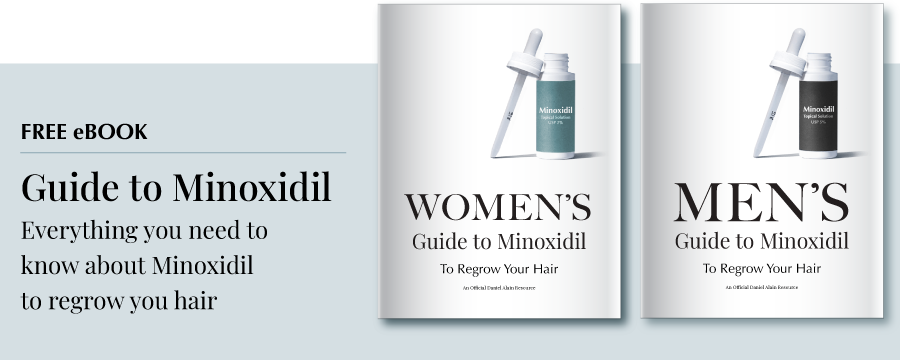Why Women Experience Hair Loss & What You Can Do About It

Hair loss in women can zap all the fun out of the hair activities you once loved. Brushing and styling are beauty rituals many women look forward to before a busy day or night out. But for women experiencing hair loss, they're painful reminders of just how many strands they're losing.
Hair loss in women is a common, yet often misunderstood condition. While it is true that men are more likely to suffer from hair loss, research shows that approximately 50% of women will experience noticeable hair loss at some point.
If you struggle with hair loss, know that you're not alone. While there is no one-size-fits-all solution, there are treatments available that can help. But first, you have to find out what's causing your hair loss in the first place.
What Causes Hair Loss in Women?
Losing your mane’s luster is especially traumatic considering how much society sees hair as symbols of femininity and beauty. The blonde bombshell, the princess who let down her hair, all of the iconic A-lister manes—healthy hair represents women's youth, power, and allure.
When we lose it, it feels like we're losing a part of ourselves.
So, why do women have hair loss in the first place?
Genetics
The leading cause of hair loss in women is (unfortunately) genetics. Women must inherit it from both parents, unlike men who only need to inherit it from one. When they do, it means their hair follicles remain in the shedding phase longer than usual, inhibiting once-regular growth.
Hormonal Changes
Our ever-changing hormones play a major role in almost every part of our lives— hair included. Menopause, birth control, PCOS, and pregnancy can cause estrogen and progesterone levels to fall, which triggers androgens (male hormones) to increase. The result? Thinner hair that's slow to grow and quick to get stuck in your hairbrush.
Stress
As much as we love to run around telling everyone how "fine" we are, women today are plagued with chronic, never-ending stress. And stress can wreak havoc on our hairline, among other painful symptoms and diseases. When we're constantly in "fight or flight" mode, our bodies produce the stress hormone cortisol. This menacing hormone moves hair follicles from active growth to active shedding.
Aging
Sometimes, there isn't anything horribly wrong that's causing your hair to fall out. In fact, loss of hair in women is perfectly normal as we age. Receding hairlines or a widenening part can happen gradually during the aging process. Our hair’s life cycle shortens over time.
Menopause
As mentioned previously, hair loss in women can result from hormonal imbalances or changes. We ride one of the most dramatic hormonal rollercoasters during menopause when estrogen levels drop significantly. This can cause thinning across the scalp, with patchy bald spots popping up out of nowhere.
Medical Conditions
Sudden or excessive hair loss could signify an underlying medical condition. If you're experiencing hair loss along with other symptoms like fatigue, weight gain/loss, changes in your menstrual cycle, or hair that's coming out in clumps, it's important to see a doctor. Medical conditions like alopecia areata, scalp infections such as ringworm, or even a hair-pulling disorder called trichotillomania could be the cause.
Medications
Several prescription medications list hair loss as a common side effect. These include blood thinners, chemotherapy drugs, antidepressants, gout medicines, and even high doses of Vitamin A. Speak with your doctor if you're concerned about hair loss due to any medication you're taking.
Radiation Therapy
Common cancer treatments like radiation therapy and chemotherapy can damage hair follicles, resulting in hair loss. Hair will usually fall out 2-4 weeks after starting treatment and will only start growing back once the treatment is complete.
Hairstyles
Certain hairstyles put excessive stress on hair follicles, leading to women's hair loss. You usually see this in women who wear their hair pulled back tightly in a bun or ponytail, resulting in traction alopecia. Many of these cases are temporary, and the hair will eventually grow back. However, if hair loss is severe or the hair does not regrow, it could be permanent.
Postpartum
After going through the stress of childbirth, it's not uncommon for hair to begin thinning 3-6 months postpartum. Postpartum alopecia is due to the sudden drop in hormones post-pregnancy. While it can feel distressing, hair will usually grow back on its own within a year.
Diet
What we eat (or don't eat) can have a major impact on our hair health. The cells swarming around in your hair follicles need nourishment and certain nutrients to grow. A diet lacking in protein, iron, omega fatty acids, calcium, biotin, and other essential vitamins can lead to a female hair loss condition called chronic telogen effluvium. To learn what foods to stock up on for hair growth, head here.
Types of Women's Hair Loss
Discovering hair clumps in the drain is enough to send anyone into a full-blown panic—especially when you have no idea why it's happening. Women's hair loss can manifest in several ways, each with its own set of causes and treatments.
However, finding the right solution is much easier if you can identify what type of hair loss you're experiencing.
Androgenetic Alopecia
One of the most common types of hair loss in women is androgenetic alopecia, also known as Female Pattern Baldness. A combination of hormones and genetics typically cause this type of hair loss. Symptoms usually include thinning hair all over the scalp. Androgenetic alopecia doesn’t always lead to total baldness, but it can if hair loss is severe.
Telogen Effluvium
Telogen effluvium hair loss is caused by a major life event or stressor (think: childbirth, job loss, loss of a loved one, serious illness). The stress shocks the hair follicles into shedding faster than usual.
With telogen effluvium, hair follicles enter a resting phase and stop producing new hair. If the stressor is a one-time event, hair loss is usually temporary, and hair will typically regrow. However, if the stress is chronic, it may be harder for the hair to grow back.
Anagen Effluvium
This kind of female hair loss results from exposure to certain chemicals or medications. Chemotherapy drugs used to treat cancer are a common cause of anagen effluvium hair loss, as they work by targeting rapidly dividing cells—like hair follicles. This type of loss of hair in women can be severe and lead to total hair loss all over the scalp. However, hair will typically regrow once the exposure to the chemicals or medications has stopped.
Alopecia Areata
Alopecia areata is an autoimmune condition that causes hair loss in patches all over the scalp or body. In some cases, hair loss is temporary and hair will eventually grow back on its own. However, for some people with alopecia areata, hair loss is permanent. There is no cure for this condition, but there are treatments that can help hair regrow, and alternative hair pieces that can conceal thinning and patches.
Traction Alopecia
Traction alopecia hair loss is caused by regularly wearing hairstyles that pull on the hair follicles, like tight ponytails, cornrows, or braids. This hair loss is often seen in people who wear tight hairstyles daily, but even wearing them for an extended period can cause hair loss. Traction alopecia is typically temporary and may subside after you reduce the frequency of tight hairstyles.
Hair Loss Symptoms for Women
Women's hair loss is often gradual and can be hard to notice at first. But being aware of common symptoms can help you catch the problem early and get the treatment you need.
More Daily Hair Fall
We each lose anywhere from 50 to 150 hair strands per day. But if you're finding more hair in your brush than usual or noticing bigger hair clumps clinging to your clothes, it could be a warning sign of hair loss.
Noticeable Patches of Missing Hair
Hair loss often starts with one or two small, round bald patches anywhere on the scalp. It could even be as subtle as a slowly widening natural hair part. If you notice any sudden changes in your hairline or start seeing patches of your scalp, it's worth investigating further.
Smaller Ponytails
Have you worn a daily ponytail for years? Look out for any sudden hair thinning or instances where the ponytail comes loose—these may indicate hair loss. A shrinking ponytail is your hair crying out for some serious TLC.
Breakage
Breakage is an all too common symptom of hair loss. If your hair feels brittle, breaks more easily, or starts to frizz and look straw-like, hair loss could be to blame. Healthy hair is strong and smooth. Damaged hair is weak, dry, and frizzy. Fortunately, bringing some much-needed hydration and nutrients to your follicles via scalp conditioners and nutrient-packed foods can minimize breakage.
Hair Thinning
Is your once-thick and lustrous hair deflating in volume and bounce? Hair loss could be the cause. Weak follicles mean that hair strands are thinner and don't grow as long as they used to. This can lead to limp and lifeless hair—and hair loss.
We’ve covered the causes, conditions, and symptoms of hair loss in women. What can you do to treat the issue?
What to Do For Women's Hair Loss
While hair loss can feel like the most isolating experience in the world, millions of women are experiencing hair loss at any given time. You are not alone. And there are things you can do to treat hair loss and improve the overall health of your hair.
Find Out if Minoxidil Will Work to Regrow Your Hair
When you think of hair loss treatments, Rogaine® might come to mind first. You may not have heard of Minoxidil, Rogaine’s® active ingredient. Minoxidil is an FDA-approved topical hair loss treatment that can stop hair loss and increase hair density in some women.
For a long time, most experts had no idea how minoxidil worked to promote hair growth. But Daniel Alain made a breakthrough discovery of specific enzyme activity necessary to convert Minoxidil into its active form. Meaning? Only people with SULT1A1 enzyme activity will experience hair growth from Minoxidil.
To figure out if you have SULT1A1 enzyme activity, Daniel Alain offers a patented Minoxidil Response Test with 95.9% accuracy. Just pluck a few hairs and send them to our lab for analysis. We'll determine if Minoxidil will work for you within a week.
Use an Anti-Hair Shedding Treatment to Retain Your Hair
Another way to improve hair density is to focus on hair retention. INTACT 5 Hair Shedding Treatment is a clinically proven, effective hair loss treatment that strengthens your hair follicles and locks your strands in place. Brushing, washing, and styling hair can cause additional shedding—which is why it's important to use a hair treatment that will help hair strands withstand the everyday stress of hair care.
Apply INTACT 5 before you hop in the shower and let its patented PiliLock® Sevilla Orange Complex work its magic. You'll see a difference in hair density and vibrance with consistent use.
Rock a Gorgeous Wig
A good wig can be a game-changer for hair loss — just ask our Follea Friends how human hair wigs have changed their lives! Premium hair that moves, bounces, glimmers in the light, and gives you the va-va-voom volume you crave can boost confidence while concealing hair loss.
There are now more options than ever before to find a luxury wig that looks natural and feels like your own hair. By far, the best kind of wig is a 100% European hair wig. Daniel Alain uses the most precious European human hair sourced from our private reserve to ensure the highest quality for every hairpiece. Ready to flip your hair every day and reclaim your confidence? Shop our collection of 100% European hair wigs to find your perfect match.
Hair Transplant Surgery
While it's more common for men, some women elect to undergo hair transplant surgery to correct hair loss. This surgical procedure involves taking hair from one part of the scalp and transplanting it to the balding or thinning area.
Hair transplant surgery can be an effective hair loss treatment, but not everyone is a candidate. The best candidates for hair transplant surgery are women who have non-hormonal hair loss causes, like traction alopecia.
Protein-Rich Plasma (PRP) Injections
PRP has long been used to treat skin and muscle conditions; however, recent research shows promise for women experiencing hair thinning or loss. This treatment involves taking a small sample of your blood and spinning it in a centrifuge to separate the platelets from blood cells.
The platelets are then injected into the scalp’s hair loss areas. The growth factors in the platelets stimulate hair growth and keep hair follicles healthy. PRP injections are a relatively new hair loss treatment, so more research is needed to determine long-term effectiveness. However, it's mainly used to treat those with androgenetic alopecia.
Discover the Best Hair Loss Treatments for You
Hair loss can feel devastating, but understanding its cause is the first step toward treatment. And luckily, treatments and solutions are abundant. At Daniel Alain, we offer an effective hair loss solution for every woman, whether that's harnessing the power of Minoxidil, reducing shedding, taking at-home genetic hair loss tests for quicker diagnosis, or rocking a fabulous new wig or topper.
No matter what stage of your hair loss journey you're in, Daniel Alain can help.
Visit our site or browse our hair loss learning center, to learn more about your options and talk to one of our resident hair experts to find the best hair loss treatment for you!
Frequently Asked Questions
While you may feel like you're the only one going through it, hair loss is a very common issue that millions of women face every day. Let's address some of the most frequently asked questions when it comes to women's hair loss so you can start the journey to regaining your confidence.
Can Hair Loss in Women Be Prevented?
There's no guaranteed way to prevent hair loss, but you can reduce your risk. Healthy hair is the foundation of hair loss prevention, so it's important to eat a nutritious diet, avoid harsh styling, and protect your hair from the sun and environmental damage. Gentle brushing, regular trims, and using hair care products specifically formulated for your hair type can also help to prevent hair loss.
The more care you put into your hair, the less likely you will experience hair loss. However, remember that sometimes hair loss can be due to genetics or other factors beyond our control.
What is the Main Reason for Hair Loss in Females?
Genetics are the most common cause of hair loss in women. If hair loss runs in your family, there's a good chance you'll experience it at some point. Hormone imbalances, stress, and underlying health conditions can also cause hair loss in women.
What Foods are Best for Women's Hair Loss?
A healthy diet is essential for hair loss prevention, but certain foods can help promote hair growth. Foods rich in iron like dark leafy greens and lean red meat are excellent for hair health, and iron is essential for hair growth. Salmon and other fatty fish are also superb for hair loss prevention, as they're packed with Omega-3 fatty acids that keep hair follicles healthy.
What is the Best Thing to Do for Female Hair Loss?
Treating your hair loss as early as possible is the best thing you can do. The sooner you start taking action, the better your chances of regaining your hair's thickness.
Can Female Hair Loss Grow Back?
Some forms of hair loss are temporary and others are more permanent. With the right treatment, you can stop hair loss. But remember: hair loss is a gradual process, so it may take some time to see results.
What is the Difference Between Hair Loss & Hair Thinning?
Hair thinning is a gradual process where hair becomes more sparse on your scalp. This is different from hair loss, which is when hair falls out in patches or clumps. Hair thinning is a very common issue, especially as we age, while hair loss can be caused by a variety of factors.
Why am I Suddenly Losing So Much Hair?
Various factors can cause sudden hair loss, including stress, hormonal imbalances, medications, diet, age, and underlying health conditions. If you're suddenly losing a lot of hair, see a doctor to rule out any underlying health issues.
How Do I Know if My Hair Loss is Stress-Related?
Stress can definitely contribute to hair loss, but it's often temporary. Usually, hair will grow back once the stressor is removed. If your hair loss is accompanied by other symptoms like fatigue, trouble sleeping, and difficulty concentrating, stress is likely the culprit. Reduce stress by getting regular exercise, spending time outdoors, and practicing relaxation techniques like meditation and yoga.
How Much Hair Falling Out is Too Much?
It's normal to shed around 50-150 hair strands each day. If you're shedding more than that, it could signify hair loss.
How Often Should You Wash Your Hair if it's Falling Out?
Shampooing too often can actually strip hair of its natural oils, making it more susceptible to damage. Washing your hair 2-3 times a week should be sufficient if you're worried about hair loss.
When Should I See a Doctor About Hair Loss?
If your hair loss is persistent and you’re not responding to over-the-counter treatments, a dermatologist can help. And if your hair loss is sudden or accompanied by other symptoms like fever, scalp pain, or patchy hair loss, it's important to see a doctor right away to rule out underlying health conditions.
How Can I Stop Worrying About Hair Loss?
Hair loss can be a very stressful experience that can take over your life if you let it. The best thing you can do is focus on the things you can control, like following a healthy diet, getting regular exercise, and managing stress. The more effort you put into loving your hair as it is, the easier it will be to accept hair loss if it does occur.
And remember, many options are available to help you cope with hair loss and regain your confidence. So don't despair, and reach out to the team at Daniel Alain for help if you need it.




